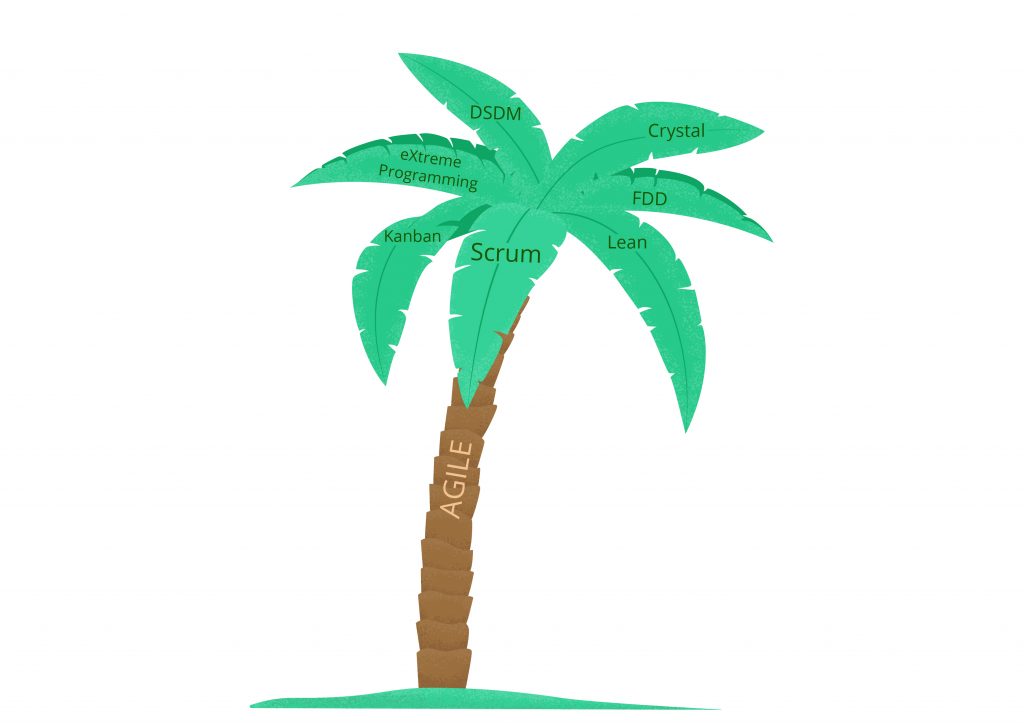What is the Difference Between Agile and Scrum?

Agile methodology introduced several advantages over the waterfall model, such as the production of features in short delivery cycles. This model of software project management seeks customer satisfaction. It promotes the release of top-notch software.
The Agile philosophy became extremely popular and was widely adopted by software development teams. However, there is still a bit of confusion, for instance, when some people talk about the difference between Agile and Scrum. This blog is dedicated to the value of Agile and Scrum for software development management.
The Principles of the Agile Methodology
Agile is a comparatively new philosophy for managing the software development process. It stands firmly on 12 principles behind the Agile Manifesto. The essence of Agile methodology can be summarized as follows:
1. Talking to people is more important than having the right set of tools.
2. It is better to have a fully-functioning product than a full-blown specification.
3. Direct communication is weightier than all of the ins and outs of the contract.
4. Readiness for changes outweighs having an original comprehensive plan.
This approach is different from the traditional linear waterfall model. Firstly, the Agile approach is characterized by changes that can happen daily. Teams are flexible enough and ready for quick adaptations.
There’s no in-depth initial planning at the kick-off of the project. The agile-based approach is open to changing requirements over time and promotes frequent end-user feedback.
Agile processes are based on iterative and incremental method. Cross-functional teams (can be compared to rugby teams, where each player has a unique role to play) work on iterations of a product over a certain time frame.
Direct communication helps enhance the workflow and clarify the tasks. Daily meetings between different team members facilitate “open sharing” and progress.
The iterations are stored in a backlog (prioritized on business or customer value). The desired outcome is a fully-functional product.
Scrum as a Type of Agile Project Management
Agile methodology describes how software is built through iterative development. Scrum is a framework (specific set of rules) for implementing Agile in software development.
Both Agile and Scrum emphasize the importance to deliver software as early as possible and as frequently as possible. Both are iterative (repetitive) processes and accept changes. They foster continuous improvement and transparency.
Agile is an umbrella term that includes approaches like Extreme Programming, Crystal, Kanban, and Scrum. Putting it simply, Scrum is a subcategory of Agile. We can compare Scrum to another branch on the Agile tree, such as Kanban, but it’s not correct to pit Agile vs. Scrum.

Unpacking Scrum
The Scrum approach to software development consists of some distinct roles and events. The development team (developers, designers, QA, et al.), Product Owner, and Scrum Master are the chief players in the Scrum process.

In Scrum, the Product Owner is the nominal client who is responsible for business decisions. They are also in charge of the product backlog (i.e., cards of “stories,” “bugs,” “tasks,” etc.). These cards help prioritize the highest-, high-, medium-, and low-priority tasks.
Before the beginning of an iteration, the backlog cards with new tasks are transferred to the new Sprint Planning Meeting. The cards will gradually move from the column “To do” to the column “Done.” At daily scrum meetings (daily scrum), the team members synchronize the progress and discuss their next steps.
The Scrum master organizes the development process: makes appointments for meetups and conducts them, addresses daily challenges, and motivates the team.
All stages of development are split up into equal periods called sprints. They average one is from 1 to 4 weeks. The length of sprints depends on the team’s capacity and the complexity of the project.
The effectiveness of work is checked during the Retrospective stage and then is improved through frequent comparison of sprints. Sprint Review takes place after the sprint is over. The team assesses the outcome of the Sprint Planning Meeting. It’s also called Demo because the functionality is demonstrated to the client.

To Recap
Agile is a software development methodology that seeks customer satisfaction by delivering shippable software regularly. Scrum is one of the many ways to implement Agile. It’s suitable for projects with rapidly changing requirements.
Firstly, the team should see for themselves if it’s advantageous to use the Agile approachto project management. Secondly, they should decide what should bring better results —Scrum or another Agile methodology.
At Alternative-spaces, we practice several methods to meet the customers’ requirements. Contact us to find how we can build your software most efficiently.
Content created by our partner, Onix-systems.
 Home
Home